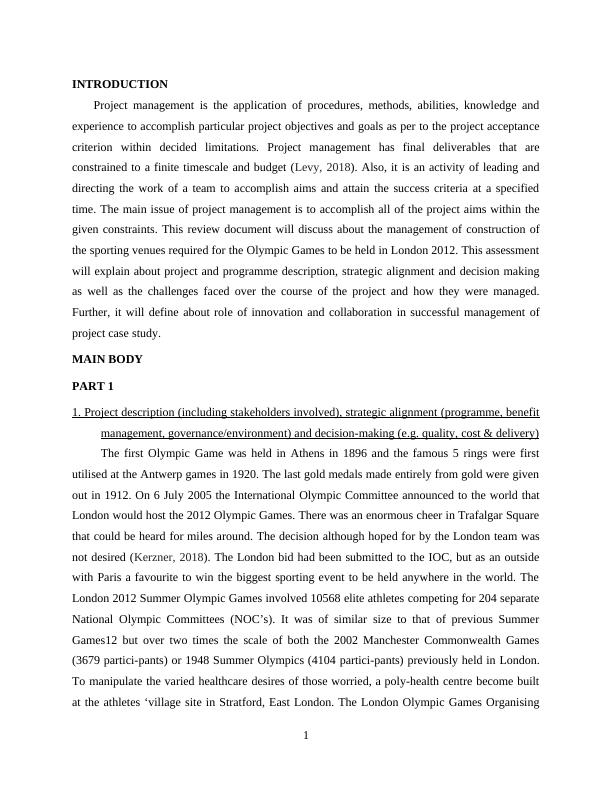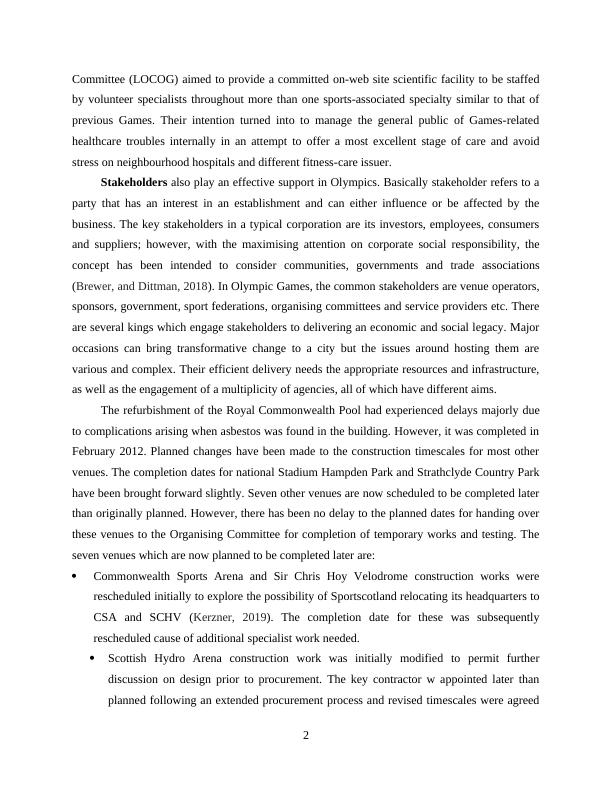Management of Construction for London 2012 Olympic Games
Added on 2022-12-15
12 Pages4099 Words294 Views
Individual Case Study


INTRODUCTION
Project management is the application of procedures, methods, abilities, knowledge and
experience to accomplish particular project objectives and goals as per to the project acceptance
criterion within decided limitations. Project management has final deliverables that are
constrained to a finite timescale and budget (Levy, 2018). Also, it is an activity of leading and
directing the work of a team to accomplish aims and attain the success criteria at a specified
time. The main issue of project management is to accomplish all of the project aims within the
given constraints. This review document will discuss about the management of construction of
the sporting venues required for the Olympic Games to be held in London 2012. This assessment
will explain about project and programme description, strategic alignment and decision making
as well as the challenges faced over the course of the project and how they were managed.
Further, it will define about role of innovation and collaboration in successful management of
project case study.
MAIN BODY
PART 1
1. Project description (including stakeholders involved), strategic alignment (programme, benefit
management, governance/environment) and decision-making (e.g. quality, cost & delivery)
The first Olympic Game was held in Athens in 1896 and the famous 5 rings were first
utilised at the Antwerp games in 1920. The last gold medals made entirely from gold were given
out in 1912. On 6 July 2005 the International Olympic Committee announced to the world that
London would host the 2012 Olympic Games. There was an enormous cheer in Trafalgar Square
that could be heard for miles around. The decision although hoped for by the London team was
not desired (Kerzner, 2018). The London bid had been submitted to the IOC, but as an outside
with Paris a favourite to win the biggest sporting event to be held anywhere in the world. The
London 2012 Summer Olympic Games involved 10568 elite athletes competing for 204 separate
National Olympic Committees (NOC’s). It was of similar size to that of previous Summer
Games12 but over two times the scale of both the 2002 Manchester Commonwealth Games
(3679 partici-pants) or 1948 Summer Olympics (4104 partici-pants) previously held in London.
To manipulate the varied healthcare desires of those worried, a poly-health centre become built
at the athletes ‘village site in Stratford, East London. The London Olympic Games Organising
1
Project management is the application of procedures, methods, abilities, knowledge and
experience to accomplish particular project objectives and goals as per to the project acceptance
criterion within decided limitations. Project management has final deliverables that are
constrained to a finite timescale and budget (Levy, 2018). Also, it is an activity of leading and
directing the work of a team to accomplish aims and attain the success criteria at a specified
time. The main issue of project management is to accomplish all of the project aims within the
given constraints. This review document will discuss about the management of construction of
the sporting venues required for the Olympic Games to be held in London 2012. This assessment
will explain about project and programme description, strategic alignment and decision making
as well as the challenges faced over the course of the project and how they were managed.
Further, it will define about role of innovation and collaboration in successful management of
project case study.
MAIN BODY
PART 1
1. Project description (including stakeholders involved), strategic alignment (programme, benefit
management, governance/environment) and decision-making (e.g. quality, cost & delivery)
The first Olympic Game was held in Athens in 1896 and the famous 5 rings were first
utilised at the Antwerp games in 1920. The last gold medals made entirely from gold were given
out in 1912. On 6 July 2005 the International Olympic Committee announced to the world that
London would host the 2012 Olympic Games. There was an enormous cheer in Trafalgar Square
that could be heard for miles around. The decision although hoped for by the London team was
not desired (Kerzner, 2018). The London bid had been submitted to the IOC, but as an outside
with Paris a favourite to win the biggest sporting event to be held anywhere in the world. The
London 2012 Summer Olympic Games involved 10568 elite athletes competing for 204 separate
National Olympic Committees (NOC’s). It was of similar size to that of previous Summer
Games12 but over two times the scale of both the 2002 Manchester Commonwealth Games
(3679 partici-pants) or 1948 Summer Olympics (4104 partici-pants) previously held in London.
To manipulate the varied healthcare desires of those worried, a poly-health centre become built
at the athletes ‘village site in Stratford, East London. The London Olympic Games Organising
1

Committee (LOCOG) aimed to provide a committed on-web site scientific facility to be staffed
by volunteer specialists throughout more than one sports-associated specialty similar to that of
previous Games. Their intention turned into to manage the general public of Games-related
healthcare troubles internally in an attempt to offer a most excellent stage of care and avoid
stress on neighbourhood hospitals and different fitness-care issuer.
Stakeholders also play an effective support in Olympics. Basically stakeholder refers to a
party that has an interest in an establishment and can either influence or be affected by the
business. The key stakeholders in a typical corporation are its investors, employees, consumers
and suppliers; however, with the maximising attention on corporate social responsibility, the
concept has been intended to consider communities, governments and trade associations
(Brewer, and Dittman, 2018). In Olympic Games, the common stakeholders are venue operators,
sponsors, government, sport federations, organising committees and service providers etc. There
are several kings which engage stakeholders to delivering an economic and social legacy. Major
occasions can bring transformative change to a city but the issues around hosting them are
various and complex. Their efficient delivery needs the appropriate resources and infrastructure,
as well as the engagement of a multiplicity of agencies, all of which have different aims.
The refurbishment of the Royal Commonwealth Pool had experienced delays majorly due
to complications arising when asbestos was found in the building. However, it was completed in
February 2012. Planned changes have been made to the construction timescales for most other
venues. The completion dates for national Stadium Hampden Park and Strathclyde Country Park
have been brought forward slightly. Seven other venues are now scheduled to be completed later
than originally planned. However, there has been no delay to the planned dates for handing over
these venues to the Organising Committee for completion of temporary works and testing. The
seven venues which are now planned to be completed later are:
Commonwealth Sports Arena and Sir Chris Hoy Velodrome construction works were
rescheduled initially to explore the possibility of Sportscotland relocating its headquarters to
CSA and SCHV (Kerzner, 2019). The completion date for these was subsequently
rescheduled cause of additional specialist work needed.
Scottish Hydro Arena construction work was initially modified to permit further
discussion on design prior to procurement. The key contractor w appointed later than
planned following an extended procurement process and revised timescales were agreed
2
by volunteer specialists throughout more than one sports-associated specialty similar to that of
previous Games. Their intention turned into to manage the general public of Games-related
healthcare troubles internally in an attempt to offer a most excellent stage of care and avoid
stress on neighbourhood hospitals and different fitness-care issuer.
Stakeholders also play an effective support in Olympics. Basically stakeholder refers to a
party that has an interest in an establishment and can either influence or be affected by the
business. The key stakeholders in a typical corporation are its investors, employees, consumers
and suppliers; however, with the maximising attention on corporate social responsibility, the
concept has been intended to consider communities, governments and trade associations
(Brewer, and Dittman, 2018). In Olympic Games, the common stakeholders are venue operators,
sponsors, government, sport federations, organising committees and service providers etc. There
are several kings which engage stakeholders to delivering an economic and social legacy. Major
occasions can bring transformative change to a city but the issues around hosting them are
various and complex. Their efficient delivery needs the appropriate resources and infrastructure,
as well as the engagement of a multiplicity of agencies, all of which have different aims.
The refurbishment of the Royal Commonwealth Pool had experienced delays majorly due
to complications arising when asbestos was found in the building. However, it was completed in
February 2012. Planned changes have been made to the construction timescales for most other
venues. The completion dates for national Stadium Hampden Park and Strathclyde Country Park
have been brought forward slightly. Seven other venues are now scheduled to be completed later
than originally planned. However, there has been no delay to the planned dates for handing over
these venues to the Organising Committee for completion of temporary works and testing. The
seven venues which are now planned to be completed later are:
Commonwealth Sports Arena and Sir Chris Hoy Velodrome construction works were
rescheduled initially to explore the possibility of Sportscotland relocating its headquarters to
CSA and SCHV (Kerzner, 2019). The completion date for these was subsequently
rescheduled cause of additional specialist work needed.
Scottish Hydro Arena construction work was initially modified to permit further
discussion on design prior to procurement. The key contractor w appointed later than
planned following an extended procurement process and revised timescales were agreed
2

End of preview
Want to access all the pages? Upload your documents or become a member.
Related Documents
2012 Olympic Games: Risk Analysis, Stakeholders and Successlg...
|10
|1359
|195
Project Management: London 2012 Olympicslg...
|17
|4296
|1
Event Managementlg...
|9
|2216
|267
Case Studies in Project Managementlg...
|16
|3640
|23
Event Management of Winter Olympicslg...
|9
|2089
|91
Attraction and Event Management - Doclg...
|7
|1805
|129